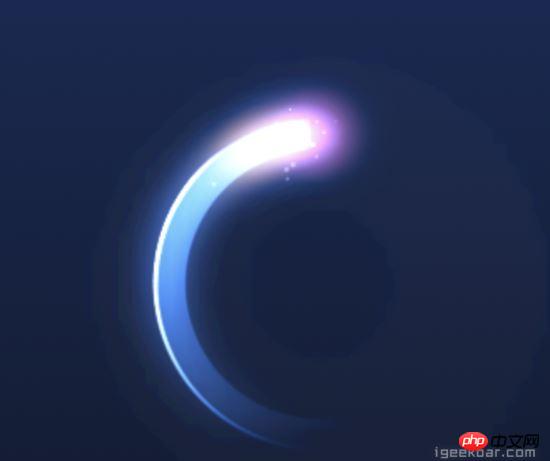Maison >interface Web >tutoriel CSS >CSS et JS réalisent le magnifique effet de mouvement de la trajectoire du ciel étoilé
CSS et JS réalisent le magnifique effet de mouvement de la trajectoire du ciel étoilé
- 小云云original
- 2018-01-31 11:16:492849parcourir
Cet article partage principalement avec vous un bel effet de mouvement de trajectoire de ciel étoilé réalisé en utilisant CSS+JS. L'éditeur ci-dessous vous apporte un exemple de code. Les amis qui en ont besoin pourront s'y référer. t'aider.
Laissez-moi d'abord partager avec vous les rendus :

Laissez-moi partager avec vous un magnifique effet de mouvement de trajectoire de ciel étoilé obtenu en utilisant CSS+JS. n'est pas inférieur à Flash . Les codes pertinents sont les suivants :
<!doctype html>
<html lang="en">
<head>
<meta charset="UTF-8">
<title>cloth</title>
<style>
body {
background: #000;
}
img {
display: block;
float: left;
margin: 0 1px 0 0;
}
canvas {
background: #131c35 linear-gradient(#192853, #131c35);
display: block;
float: left;
/* uncomment to test overlay */
/*
position: absolute;
left: 0;
opacity: .5;
top: 0;
*/
}
</style>
</head>
<body>
<p id="container"></p>
<script type="text/javascript" src="http://cdn.gbtags.com/jquery/1.11.1/jquery.min.js"></script>
<canvas id="c"></canvas>
<img src="http://dribbble.s3.amazonaws.com/users/36991/screenshots/674715/game.png" />
<script>
var c = document.getElementById('c'),
ctx = c.getContext('2d'),
cw = c.width = 400,
ch = c.height = 300,
rand = function(a,b){return ~~((Math.random()*(b-a+1))+a);},
dToR = function(degrees){
return degrees * (Math.PI / 180);
},
circle = {
x: (cw / 2) + 5,
y: (ch / 2) + 22,
radius: 90,
speed: 2,
rotation: 0,
angleStart: 270,
angleEnd: 90,
hue: 220,
thickness: 18,
blur: 25
},
particles = [],
particleMax = 100,
updateCircle = function(){
if(circle.rotation < 360){
circle.rotation += circle.speed;
} else {
circle.rotation = 0;
}
},
renderCircle = function(){
ctx.save();
ctx.translate(circle.x, circle.y);
ctx.rotate(dToR(circle.rotation));
ctx.beginPath();
ctx.arc(0, 0, circle.radius, dToR(circle.angleStart), dToR(circle.angleEnd), true);
ctx.lineWidth = circle.thickness;
ctx.strokeStyle = gradient1;
ctx.stroke();
ctx.restore();
},
renderCircleBorder = function(){
ctx.save();
ctx.translate(circle.x, circle.y);
ctx.rotate(dToR(circle.rotation));
ctx.beginPath();
ctx.arc(0, 0, circle.radius + (circle.thickness/2), dToR(circle.angleStart), dToR(circle.angleEnd), true);
ctx.lineWidth = 2;
ctx.strokeStyle = gradient2;
ctx.stroke();
ctx.restore();
},
renderCircleFlare = function(){
ctx.save();
ctx.translate(circle.x, circle.y);
ctx.rotate(dToR(circle.rotation+185));
ctx.scale(1,1);
ctx.beginPath();
ctx.arc(0, circle.radius, 30, 0, Math.PI *2, false);
ctx.closePath();
var gradient3 = ctx.createRadialGradient(0, circle.radius, 0, 0, circle.radius, 30);
gradient3.addColorStop(0, 'hsla(330, 50%, 50%, .35)');
gradient3.addColorStop(1, 'hsla(330, 50%, 50%, 0)');
ctx.fillStyle = gradient3;
ctx.fill();
ctx.restore();
},
renderCircleFlare2 = function(){
ctx.save();
ctx.translate(circle.x, circle.y);
ctx.rotate(dToR(circle.rotation+165));
ctx.scale(1.5,1);
ctx.beginPath();
ctx.arc(0, circle.radius, 25, 0, Math.PI *2, false);
ctx.closePath();
var gradient4 = ctx.createRadialGradient(0, circle.radius, 0, 0, circle.radius, 25);
gradient4.addColorStop(0, 'hsla(30, 100%, 50%, .2)');
gradient4.addColorStop(1, 'hsla(30, 100%, 50%, 0)');
ctx.fillStyle = gradient4;
ctx.fill();
ctx.restore();
},
createParticles = function(){
if(particles.length < particleMax){
particles.push({
x: (circle.x + circle.radius * Math.cos(dToR(circle.rotation-85))) + (rand(0, circle.thickness*2) - circle.thickness),
y: (circle.y + circle.radius * Math.sin(dToR(circle.rotation-85))) + (rand(0, circle.thickness*2) - circle.thickness),
vx: (rand(0, 100)-50)/1000,
vy: (rand(0, 100)-50)/1000,
radius: rand(1, 6)/2,
alpha: rand(10, 20)/100
});
}
},
updateParticles = function(){
var i = particles.length;
while(i--){
var p = particles[i];
p.vx += (rand(0, 100)-50)/750;
p.vy += (rand(0, 100)-50)/750;
p.x += p.vx;
p.y += p.vy;
p.alpha -= .01;
if(p.alpha < .02){
particles.splice(i, 1)
}
}
},
renderParticles = function(){
var i = particles.length;
while(i--){
var p = particles[i];
ctx.beginPath();
ctx.fillRect(p.x, p.y, p.radius, p.radius);
ctx.closePath();
ctx.fillStyle = 'hsla(0, 0%, 100%, '+p.alpha+')';
}
},
clear = function(){
ctx.globalCompositeOperation = 'destination-out';
ctx.fillStyle = 'rgba(0, 0, 0, .1)';
ctx.fillRect(0, 0, cw, ch);
ctx.globalCompositeOperation = 'lighter';
}
loop = function(){
clear();
updateCircle();
renderCircle();
renderCircleBorder();
renderCircleFlare();
renderCircleFlare2();
createParticles();
updateParticles();
renderParticles();
}
/* Append Canvas */
//document.body.appendChild(c);
/* Set Constant Properties */
ctx.shadowBlur = circle.blur;
ctx.shadowColor = 'hsla('+circle.hue+', 80%, 60%, 1)';
ctx.lineCap = 'round'
var gradient1 = ctx.createLinearGradient(0, -circle.radius, 0, circle.radius);
gradient1.addColorStop(0, 'hsla('+circle.hue+', 60%, 50%, .25)');
gradient1.addColorStop(1, 'hsla('+circle.hue+', 60%, 50%, 0)');
var gradient2 = ctx.createLinearGradient(0, -circle.radius, 0, circle.radius);
gradient2.addColorStop(0, 'hsla('+circle.hue+', 100%, 50%, 0)');
gradient2.addColorStop(.1, 'hsla('+circle.hue+', 100%, 100%, .7)');
gradient2.addColorStop(1, 'hsla('+circle.hue+', 100%, 50%, 0)');
/* Loop It, Loop It Good */
setInterval(loop, 16);
</script>
</body>
</html>
-Recommandations associées :
Deux méthodes JS pour réaliser le mouvement de trajectoire parabolique de la balle
Implémentation de trajectoire de mouvement circulaire en animation CSS3
Ce qui précède est le contenu détaillé de. pour plus d'informations, suivez d'autres articles connexes sur le site Web de PHP en chinois!

